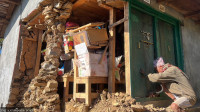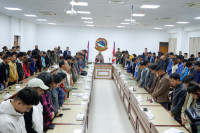Opinion
Time to go big
Imagine a society where women entrepreneurs export products to meet international demand
Mona Shrestha Adhikari
This year, the theme for the International Women’s Day is ‘Empowering Women, Empowering Humanity: Picture it!’ 2015 is also an important year as it marks the 20th anniversary of 189 governments, including Nepal, signing the Beijing Platform for Action (BPFA), better known as a historic roadmap of concrete actions to advance the agenda of women’s rights. The Beijing Platform highlights 12 critical areas of concern, one of them being women and the economy. Over the years, economic empowerment of women has increasingly become the focus of development initiatives aimed at reducing poverty, eliminating gender and social inequities, and promoting economic growth.
An increase in trade is one of pillars that promote economic growth of a country. This is reflected in Nepal’s Trade Policy 2009, which aims at increasing income and employment opportunities by enhancing competitiveness of trade in goods and services, and by using trade as a means of poverty alleviation. The Nepal Trade Integration Strategy (NTIS) 2010 has identified 19 goods and services sectors, and laid out a possible course of action for the development of the country’s export sector, with a view to support the government’s agenda of ‘inclusive growth’.
While considerable progress has been made in economically empowering women through various development interventions by bilateral and multilateral organisations, the government, private sector and civil society, there is much more that needs to be done.
‘Feminine skills’
Women business enterprises produce goods and/or deliver services and try their best to be competitive in meeting market demands. Organisations like the Federation of Women Entrepreneurs’ Association of Nepal and the Federation of Business and Professional Women Nepal have been empowering women entrepreneurs by linking them with the market and by helping them increase the opportunities for business.
The government acknowledges the significant contribution made by small and medium enterprises at the local level. Women account for the majority of the small and medium enterprises in both formal and informal sector, as people think that the nature of work demands so-called ‘feminine skills’.
Women, who have been trained by various agencies and are employed, show interest in setting up their own businesses, often small in scale. The path, however, is not easy. While some struggle to start and establish, many of them are forced to forgo their dreams and passions early on. Those who survive need to scale up their businesses from small to medium to large. As very few women entrepreneurs become leaders in the business community, the challenges continue.
Always small
Recently, South Asia Watch on Trade, Economics and Environment—a regional think-tank focusing on challenges faced by women in micro, small and medium enterprises-studied women involved in producing two products, allo and handmade paper. Allo, also known as the Himalayan stinging nettle, is a herb, whose fibres when processed can also be used to produce carpets.
The study found that these women faced several impediments while trying to export their products to neighbouring countri es, particularly India. The challenges can be clustered into three categories: supply-side constraints, lack of marketing and business development opportunities, and access to and control over resources. Examples of supply-side constraints are quantity and quality of goods, and procedural hurdles at custom clearing points. The latter is the reason most women entrepreneurs do not get involved in exporting their goods directly. Instead, they outsource this task to freight forwarder companies.
The findings of the study are similar to that of others, which identify the challenges faced by women entrepreneurs in other sectors, even when focusing predominantly, if not exclusively, on the domestic market.
Developing capacity
Being aware of the challenges, but not able to address them effectively undermines the ability of women entrepreneurs to thrive. Not only does this contribute to increased economic vulnerability of women entrepreneurs, as well as of (women) workers, but it also results in serious loss to Nepali economy. In order to help these women take advantage of the market, both domestic and regional, several actions need to be taken on various fronts.
First, coherent policies and practices must be implemented to economically empower women entrepreneurs and to develop export-oriented small and medium businesses capable of competing in international markets. There is a need for women-friendly economic policies-such as reduced registration fees and tax rebates—and mass awareness about such policies. These policies should also be well presented, considered and discussed in public-private dialogues on trade and economic spheres.
Second, investments should be made on enhancing women entrepreneurs’ capacity to develop business plans, set prices, negotiate with buyers and understand market demands, among others. These women also need a platform to exhibit their products in fairs and exhibitions. Such an exhibition will encourage the women to produce quality products, deliver quality service and establish market linkages. Programmes and projects, which address economic empowerment of women, must include the products listed in NTIS. Third, finance institutions must develop and promote special credit facilities—such as collateral-free loans, low interest loan rates, and simple documentation requirements—to encourage women to set up and establish their business.
This is a right time to envision a society where women entrepreneurs are empowered, where they produce and export products to meet local, regional and international demand.
Adhikari is a development consultant based in Geneva




 14.12°C Kathmandu
14.12°C Kathmandu










